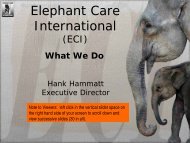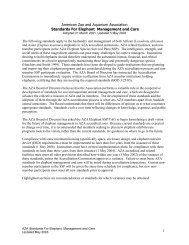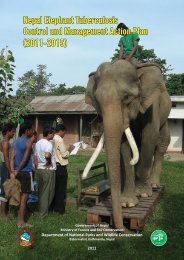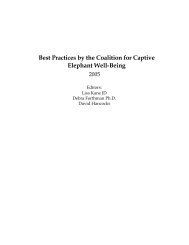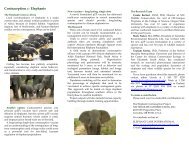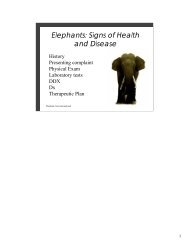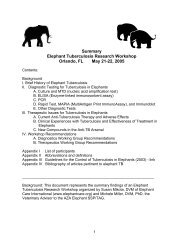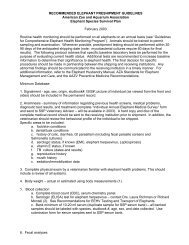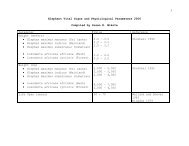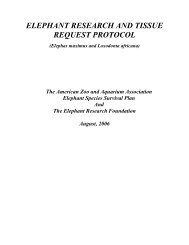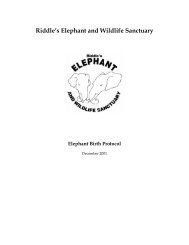Elephants Elephants - Wildpro - Twycross Zoo
Elephants Elephants - Wildpro - Twycross Zoo
Elephants Elephants - Wildpro - Twycross Zoo
- No tags were found...
You also want an ePaper? Increase the reach of your titles
YUMPU automatically turns print PDFs into web optimized ePapers that Google loves.
3.3.1 Social Structure<strong>Elephants</strong> are one of the most social mammals and this should be borne inmind when managing them in captivity. <strong>Zoo</strong>s MUST maintain elephants inas appropriate a social group as possible so that welfare needs, education andconservation potential can all be fully realised. The best way to achieve this isto replicate the social organisation seen in the wild. The broad similaritybetween the social organisation of African and Asian elephants means thatmanagement recommendations for the social environment is essentially thesame for both species, however Asian and African animals MUST not bemixed in the same social grouping.There is a need for the maintenance of appropriate social units not only forwelfare and educational grounds but also for conservation. Conservationdoes not merely entail the preservation of genetic diversity, which, arguably,could be carried out far more cheaply in cryo-preserved gene banks, butMUST provide for the preservation of ‘cultural’ and learnt elements of ananimals natural behaviour. In elephants, as in the great apes, much of theirbehavioural repertoire is learnt rather than innate; so that to truly ‘conserve’as opposed to ‘preserve’ elephants in captivity as many naturally learntbehaviours and cultural elements should be maintained as possible.COWSThe basic social unit of the elephant is the family unit (see Section 2.9). If notkeeping a bachelor herd, zoos MUST establish stable female groups,preferably of related animals, in order to replicate the wild state. Thus zoosMUST strive to keep a minimum group size of four compatible cows olderthan two years 1 . <strong>Zoo</strong>s SHOULD STRIVE to ensure that for not less than 16hours in any given 24 hour period, save in exceptional circumstances,compatible females have unrestricted access to each other. Thus whilstelephant facilities MUST retain the potential to separate elephants asrequired, routine and prolonged separation of compatible cows MUST not bepractised. Separation is taken to include any barrier which restricts completephysical access. Facilities which have compatibility issues, such thatindividual cows are kept separated for prolonged periods of time, MUSTensure that these situations are resolved expediently. In these circumstances,the removal of individual elephants may be justified.Particular care should be taken when leaving elephant groups unattended,particularly in houses. An objective assessment of risk of injury MUST beundertaken before giving unrestricted access to the house and each other forthe first time. Staff should monitor the animals and be available to intervene ifrequired and safe to do so.Cows should be reviewed as to whether they should go into protected contact.Once an animal has physically challenged a keeper it MUST be put into1 This section has been clarified.38



